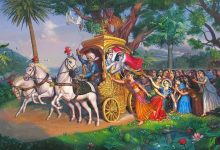The picturesque northernmost Indian state of Jammu& Kashmir has its own distinct cultural heritage. Here, in a nutshell, are their wedding customs and traditions of the Kashmiri Hindus.
A matrimonial alliance is fixed once the horoscopes match. For the Kasamdry (formal engagement), the two parties assemble at a temple. Prayers are followed by an exchange of flowers – in the hope of a blissful and harmonious union. Later aunts of both bride and groom get down preparing Var (traditional rice pudding) to be fed to guests, friends, and relatives. To maintain the festive tempo during the interval between the engagement and the D-Day, the bride’s family customarily sends 51 platters –containing fruits, dry fruits, sweets, a pot of nabad (sugar candy) and other eatables – to the groom’s family The groom’s family reciprocates by dispatching floral ornaments, cosmetics, and other accessories to the bride’s home on the morning of the wedding. This is known as Phoolon Ka Gehna and Snazaroo.
Kanishran is a pre-wedding ritual where the bride/groom is ceremonially bathed with water, milk, curd, and rice in their respective homes. Thereafter, the bride/groom don new clothes and the bride bestowed lots of useful gifts by her kin. Another pre-wedding ritual is Devagon. The bride and groom offer prayers to Goddess Parvati and Lord Shiva through an elaborate ceremony, in their respective homes. Later, in the day all maternal relatives of the groom and the bride are invited to lunch at the respective homes. This is known as Duribat.
 On the day night before the wedding, Maenziraat is observed at the bride’s home. After a thorough wash of the bride’s hands and feet by a maternal aunt, dollops of Henna paste is used to cover the hands and feet with breathtaking designs. Mehendi is a low key affair at the groom’s home.
On the day night before the wedding, Maenziraat is observed at the bride’s home. After a thorough wash of the bride’s hands and feet by a maternal aunt, dollops of Henna paste is used to cover the hands and feet with breathtaking designs. Mehendi is a low key affair at the groom’s home.
A look at the wedding attire. The Kashmiri groom wears a Pheran, tied at the waist with louing – a pashmina wool waistband embroidered with golden threads. A male relative ties a turban Gordstar on the groom’s head. The groom must customarily wear Paazar the traditional Kashmiri footwear. He adorns his neck with a special gold necklace bedecked with pearls and gems. A traditional bride wears an ornate, Pheran along with a veil. The dress is heavily decorated with intricate zari work and traditional embroidery. The bride’s headgear is known as Tarang. It consists of a Kalpush, which is folded three or four times. A white cloth known as zoojh is wrapped over the Kalpush in three or four layers. A Kashmiri bride wears heavy necklaces, ornamental bangles, and anklets. She also wears a Dejharoo– equivalent to a Mangalsutra worn by brides in other Indian states. It comprises a gem-studded gold pendant connected to a huge gold chain. This rather heavy ornament is strung through the pierced ear of the bride and then tucked in her hair. She also dons an elaborate waistband.
On the wedding day, as the groom prepares to leave home, a female relative touches his left shoulder with a plate containing rice and some money. Armed with a sword the groom mounts a mare, and heads towards the bride’s house accompanied by his male relatives. After they reach the bridal home, as part of the ceremonial welcome, the fathers of the bride and the groom exchange nutmeg – symbolising mutual acceptance of the alliance. Conch shells are blown to mark the auspicious occasion. The priest performs a Mandap puja followed by the Dwar puja before ushering in the groom. The bride is taken to the wedding mandap by her maternal uncle. The heads of the bride and groom are covered with a sacred cloth and a large mirror is inserted under the cover. The couple’s eyes meet for the first time in the reflection of the mirror. The bride’s father places the hand of the bride over the groom’s hands symbolically giving her away to the groom. For the rest of the ceremony, the groom is to clasp the bride’s hand. The hands are covered by special cloth Athwas. A golden thread Mananmal is tied to their foreheads. After the priest lights the sacred fire the bride and groom take seven Pheras around the fire. This is followed by the Saptapadi where the couple takes seven symbolic steps while uttering the seven marriage vows. Friends and family gather around the couple and offer flowers or posh to the couple, accompanied by chanting of Vedic mantras by the priest.
Once the wedding is over, the newlyweds are involved in some post-wedding frolic and games e.g.  hunting for a ring in a pot filled with rice. Before the bride leaves for her new home, the newlyweds are made to stand next to each other on Vyoog a wooden pedestal. The eldest female relative of the bride offers them nabad (sugar candy) or rice thrice and kisses them on the forehead. The bride then throws a handful of paddy, over her shoulder in the direction of the house praying for its prosperity once she is gone. On the other hand, she carries some more paddy to scatter over the doorstep of her new home.
hunting for a ring in a pot filled with rice. Before the bride leaves for her new home, the newlyweds are made to stand next to each other on Vyoog a wooden pedestal. The eldest female relative of the bride offers them nabad (sugar candy) or rice thrice and kisses them on the forehead. The bride then throws a handful of paddy, over her shoulder in the direction of the house praying for its prosperity once she is gone. On the other hand, she carries some more paddy to scatter over the doorstep of her new home.
When the bride arrives at her in-law’s house, the couple is fed some nabad. The Manamal tied on their heads are exchanged. A couple of pigeons is released into the air in honor of the couple. For the Saatraat ceremony, the couple visits her parent’s house accompanied by one or more kids. Here the couple is treated to a lavish meal and gifted new clothes, which they must wear before going back home. For Phirlath the bride’s parents visit the groom’s house, carrying more gifts for the newlyweds. The groom’s family hosts a lunch for the visitors. The wedding is rounded off with a ritual known as Ghar Atchum. On this occasion, a lavish nonvegetarian lunch for all invitees is organised by the bride’s family to celebrate the happy occasion.
©Ruchira Adhikari Ghosh
Photos from the Internet
#KashmiriWedding #RitualsOfKashmiriWedding #IndianWeddings #HinduWeddings #CultureAndRituals #SliceOfLife #DifferentTruths







 By
By
 By
By
 By
By
 By
By